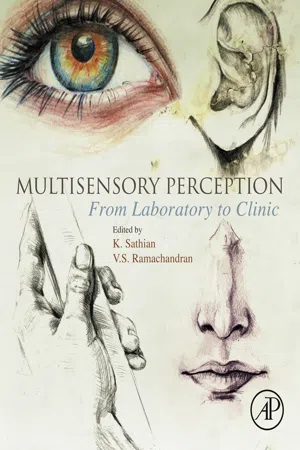
- 488 pages
- English
- ePUB (mobile friendly)
- Available on iOS & Android
About this book
Multisensory Perception: From Laboratory to Clinic surveys the current state of knowledge on multisensory processes, synthesizing information from diverse streams of research and defining hypotheses and questions to direct future work. Reflecting the nature of the field, the book is interdisciplinary, comprising the findings and views of writers with diverse backgrounds and varied methods, including psychophysical, neuroanatomical, neurophysiological and neuroimaging approaches. Sections cover basic principles, specific interactions between the senses, the topic of crossmodal correspondences between particular sensory attributes, the related topic of synesthesia, and the clinic.- Offers a comprehensive, up-to-date overview of the current state of knowledge on multisensory processes- Coverage includes basic principles, specific interactions between the senses, crossmodal correspondences and the clinical aspects of multisensory processes- Includes psychophysical, neuroanatomical, neurophysiological and neuroimaging approaches
Frequently asked questions
- Essential is ideal for learners and professionals who enjoy exploring a wide range of subjects. Access the Essential Library with 800,000+ trusted titles and best-sellers across business, personal growth, and the humanities. Includes unlimited reading time and Standard Read Aloud voice.
- Complete: Perfect for advanced learners and researchers needing full, unrestricted access. Unlock 1.4M+ books across hundreds of subjects, including academic and specialized titles. The Complete Plan also includes advanced features like Premium Read Aloud and Research Assistant.
Please note we cannot support devices running on iOS 13 and Android 7 or earlier. Learn more about using the app.
Information
Visuo-haptic object perception
Abstract
Keywords
Introduction
Haptic and visuo-haptic object recognition
Behavioral studies
Table of contents
- Cover image
- Title page
- Table of Contents
- Copyright
- Contributors
- Preface
- Section I. Foundations of multisensory perception
- Section II. Multisensory interactions
- Section III. Clinical applications
- Index